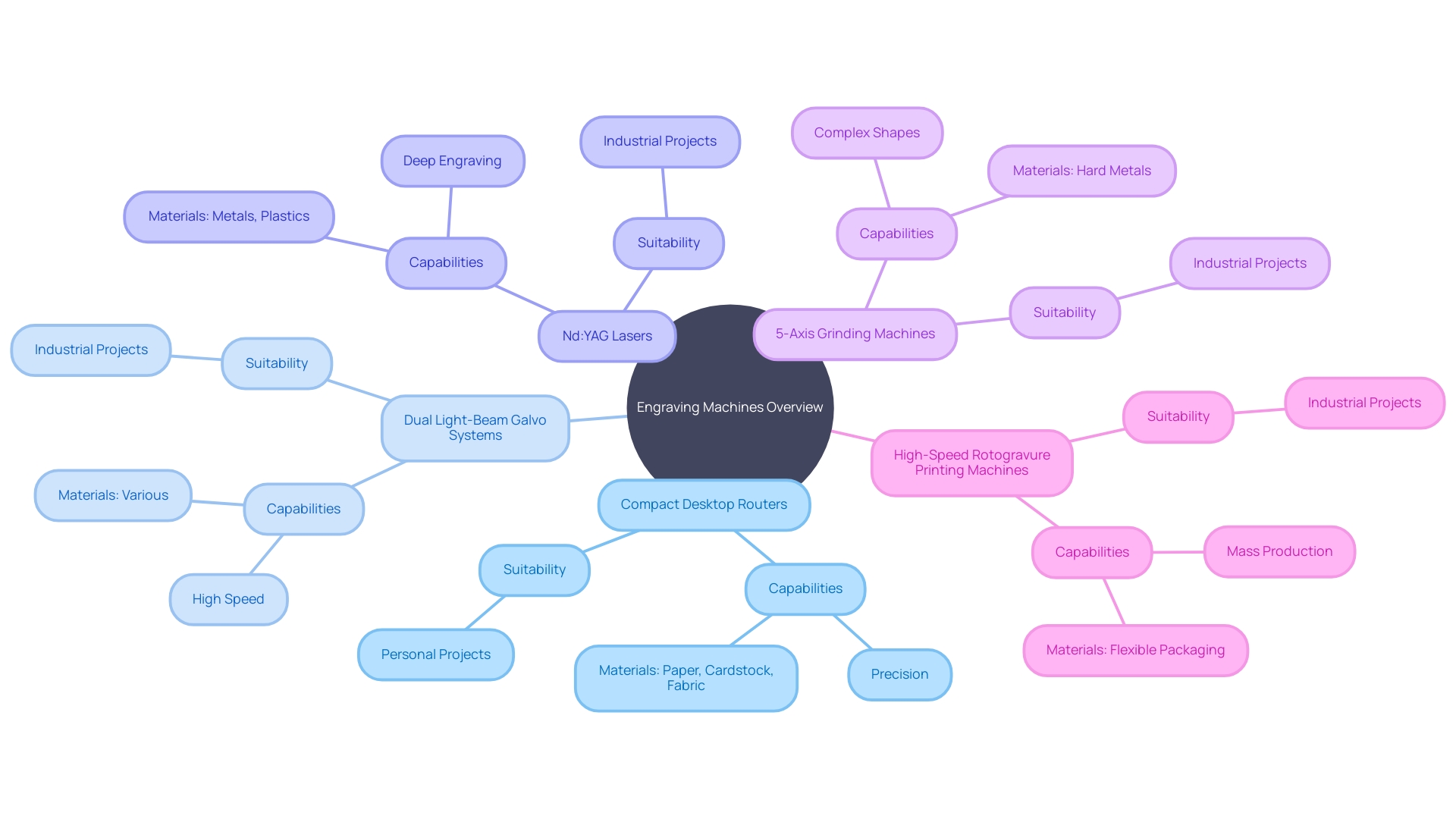Introduction
Choosing the right type of stainless steel for engraving is crucial for the success of your project. Just like artists carefully select their mediums and jewelers choose the best equipment, precision is required when it comes to stainless steel. Different grades offer various levels of corrosion resistance and cost-effectiveness.
The 304 series is popular for its balance of these factors, while grade 316 is ideal for environments requiring maximum durability. On the other hand, the 430 grade is cost-efficient for less demanding applications. The stainless steel grade you choose will influence the longevity, appearance, and overall success of your engraving project.
So, dive into the specifics of each type and understand that the material you select is as significant as the design you will engrave upon it.
Choosing the Right Type of Stainless Steel
Choosing the ideal quality of metal for etching is similar to selecting the appropriate surface for a masterpiece. Just as artists like Jordan Poles carefully choose their mediums or how jewelers seek the best equipment like the MIRA-6S for their intricate designs, the same precision is required in selecting a type of metal. The 304 series offers a balance of corrosion resistance and cost-effectiveness, making it a popular choice for projects where higher-grade materials like 316 aren't required. However, for environments where maximum durability is vital, grade 316, with its superior corrosion resistance, is the go-to option. In contrast, the 430 grade is cost-efficient for less demanding applications, providing a satisfactory surface for engraving without breaking the bank.
As we consider the fusion of aesthetics and function, it's worth noting that the pursuit of innovation and sustainability in metalworking is a continuous journey. Companies like Sandvik Coromant are pioneering the way forward, underscoring the importance of thoughtful material selection in every creative and industrial endeavor. This mindset echoes the meticulous approach of artists layering paint to create something unique, like the Fordite method, where each layer's interaction contributes to the final outcome.
Whether you're personalizing a watch and choosing to engrave discreetly on the case back or designing a bespoke pendant, the grade of metal you select is crucial. It's a decision that influences the longevity, appearance, and overall success of your project. So, delve into the specifics of each type of metal with the understanding that this choice is as significant as the design you'll engrave upon it. After all, the right material is not just a backdrop, but a key player in the symphony of creation.

Cleaning and Preparing the Stainless Steel Surface
The crucial initial stage in laser etching stainless metal is making sure the surface of the material is flawlessly spotless. Even minor traces of contaminants can dramatically interfere with the engraving quality. Start this meticulous process by wiping down the metal with a mild detergent or a specialized cleaning agent to remove any surface filth. After a thorough rinse, dry the metal meticulously with a lint-free cloth. To take cleanliness to the next level, treat the surface with isopropyl alcohol or acetone. This final touch removes persistent residues and guarantees a pristine surface. Now, with the steel surface flawlessly prepared and bone-dry, you're all set to start the artistic etching adventure with confidence.
Selecting the Appropriate Engraving Machine or Tools
When selecting an engraving machine or tool, precision is paramount. For those embarking on projects like Jordan Poles, who successfully engraved a brass ring using a compact desktop router, the choice of machine can make all the difference. In similar vein, xTool's upcoming F1 Ultra, the first dual light-beam galvo system of its kind, exemplifies the industry's move towards devices that offer both high precision and convenience. With a 20W fiber and 20W blue diode light source, this compact powerhouse can engrave materials from wood to light metals right from your desk.
Furthermore, the flexibility of Nd:YAG lasers, capable of cutting and welding, emphasizes the significance of adaptability in the field of etching. Like Romi's operations, having a familiar interface across machines can minimize mistakes, opting for a machine with an intuitive control system can streamline workflow.
When customizing items like watches, where aesthetics are crucial, the technology for adding fine details must not compromise the item's integrity. The TX7 Linear's 5-axis grinding machine is a testament to how additional axes can expand the capabilities of traditional 3-axis machines, allowing for more complex operations.
Whether for personal projects or industrial applications, the appropriate tool for creating intricate designs is available. With the flexible packaging market growing at a CAGR of 4.9% and the rise in technical innovations, the industry of etching is evolving. High-speed rotogravure printing machines are now enhancing production with automated processes, showcasing the industry's progress. When selecting a machine for etching, take into account the dimensions of the etching area, the intricacy of your design, and your budget to discover the ideal option for your requirements.

Setting Up the Laser Engraver
Setting up your etching machine correctly is the linchpin for achieving impeccable marks on metal. Begin by positioning the machine on a surface that's both stable and level to avoid any inaccuracies during operation. Once you've established a secure connection to a dependable power source, double-check that all cables are firmly connected. The center of attention of your beam is crucial, so adjust it with the thickness of the stainless steel in mind. It's worth mentioning that the CO₂ machines, commonly used for their versatility, often come with user-friendly interfaces and the ability to integrate with robotic arms, enhancing precision in pattern following.
Tapping into the knowledge base provided by manufacturers, such as comprehensive setup guides and safety measures, will streamline the setup process. This hands-on learning experience is vital, as echoed in the journey of Jordan Poles who, with a bit of ingenuity, modified a machine to engrave a brass ring. Similarly, companies like Tooling Tech Group and Davi Inc. emphasize the importance of customer support post-purchase, offering training and preventive maintenance to ensure peak performance of their machines.
Remember, the transformation of manufacturing through advanced light technology is not just about the machines; it's about the meticulous processes and advancements that have been made. The precision and efficiency of these tools—capable of everything from texturing to cutting with micron-scale accuracy—have propelled them from niche applications to the forefront of manufacturing. As technology advances, your understanding of these evolving laser techniques will guarantee that your projects are not only superior, but set the standard for excellence in the field.
Design Preparation for Engraving
When it comes to customizing metallic objects, like a striking timepiece or a work of art, etching can provide that distinctive element that honors a momentous occasion or even acts as a one-of-a-kind marker. The initial step in this transformative process is devising a design that resonates with your vision. From the intricacy of the graphics to the precision of the text, every detail counts. Utilize sophisticated graphic design software to craft or refine your masterpiece, ensuring it's scaled to perfection for the stainless steel canvas you'll be working with. Compatibility with the machinery is crucial, so adjusting your design to the appropriate file format is a vital preparatory step. This meticulous approach to design preparation can make all the difference, much like the innovative MiConnect Technology that revolutionized programming in manufacturing environments, saving time and reducing dependency on original programmers for adjustments.
Understanding the capabilities of your equipment is also essential. Take inspiration from Jordan Poles' project, where a compact yet capable desktop router was employed to engrave a brass ring, showcasing that even smaller machines can achieve impressive results with the right modifications. Similarly, when Seven Hills Design aimed to express a clean, geometric brand identity for their product designs, they emphasized simplicity and precision, qualities that are equally crucial in the art of etching. Essentially, thorough design preparation, knowing your tools, and matching the item's aesthetics are the foundations of successful etching on metal, guaranteeing that the end result is both useful and visually appealing.

Laser Engraving Process
Laser engraving has revolutionized the way we mark and personalize items, from jewelry to industrial parts. The procedure, which employs a focused ray of light to engrave into a specific metal, necessitates accuracy and comprehension of the light's interaction with the substance. To engrave effectively, start by securing the stainless steel piece, ensuring it does not shift during the process. Next, carefully fine-tune the device's parameters, such as intensity, velocity, and repetition rate, to match both the substance and the intended level of marking.
Proper positioning of the light beam is crucial for accuracy, and a steady hand or a reliable machine is key to achieving the desired results. The real etching is a combination of artistic and scientific elements, as the focused light carefully follows the pattern, turning the stainless steel into a surface that highlights the complexity of your craftsmanship. After the engraving is complete, the piece emerges with a customized, refined appearance that stands the test of time.
Engraving technology has come a long way from the days when CO2 light beams were power-hungry giants. Nowadays, engravers that use advanced light technology are much more efficient and accurate, thanks to advancements in the source of light and pulse technology that are propelling the industry. Companies such as Tooling Tech Group utilize cutting-edge tooling and automation solutions, including advanced laser etching, to cater to a wide array of industries. The careful process of using a focused light beam to create designs, the selection of a specific type of strong metal, and the machinery utilized all contribute to the excellence of the final outcome.
The customization of items like watches, where even a small area can be utilized for a significant inscription, showcases the laser's versatility. Engraved items can carry significant sentimental value, commemorating special moments or achievements. Whether you’re marking a piece of industrial equipment or creating a one-of-a-kind gift, the process remains the same: precise, controlled, and capable of delivering exceptional results.

Post-Engraving Care and Cleaning
To maintain the integrity and visual appeal of your laser-engraved stainless steel items, it's crucial to perform post-engraving care. Start by carefully inspecting for any flaws or unevenness in the etching. A gentle fabric or brush can do magic in removing any remaining dirt from the site where the carving was done. When needed, select a mild detergent or a specialized cleaning product for a thorough cleanse of the metal surface. Always ensure a complete rinse, followed by drying with a lint-free cloth. Avoid using rough substances or strong chemicals that could damage both the etching and the material itself. By adopting these careful cleaning practices, you'll preserve the quality and aesthetics of your engraved pieces for the long haul.
Tips for Successful Engraving on Stainless Steel
Becoming proficient in the skill of etching on stainless steel, similar to creating a unique piece of jewelry, requires accuracy and a comprehension of the interaction between materials and technology. To elevate your engraving proficiency, consider embracing high-caliber tools that not only enhance accuracy but also bestow your work with an artisanal touch. As you maneuver through the intricate dance of beam settings, aim to carve out the perfect depth and contrast, akin to the meticulous layering seen in the Fordite method, which transmutes random splashes of paint into a symphony of color on canvas.
Before etching your final design, like sketching out a blueprint, test your approach on a scrap of stainless material. This not only ensures refinement but also mirrors the thoughtful practice of repurposing materials, as seen in the creation of lightweight aluminum necklaces from ordinary soda cans. To safeguard your masterpiece from the heat's harsh embrace, consider using masking tape or a laser marking spray, much like an artist preparing their canvas with a protective layer.
In the pursuit of perfection, remember to pause and allow both the metal and the machinery to rest, preventing overheating – a practice reminiscent of taking a step back to view a painting in progress. Keep a stash of spare parts within arm's reach, ensuring that you can swiftly respond to the unexpected, maintaining the rhythm of your work without missing a beat.
Lastly, as every skilled craftsman would attest, safety is paramount. Wear protective eyewear and gloves, turning the process of carving into a harmonious combination of creativity and thoughtful deliberation, similar to Sandvik Coromant's dedication to sustainable practices and the welfare of both the surroundings and its individuals.

Common Applications of Stainless Steel Engraving
Laser engraving on metal is not just about creating visually appealing designs; it's a practice that intertwines technology, art, and functionality. With its resistance to corrosion and a modern aesthetic, stainless steel remains the preferred material for a wide range of applications, from the iconic art deco skyscrapers of the Chrysler Building to the essential surgical instruments used in healthcare. The material's flexibility allows for a variety of uses such as personalized jewelry that stands the test of time, industrial labeling that resists harsh environments, and customized promotional items that carry a brand's legacy.
The renowned architecture of the 30s, such as the Chrysler and Empire State buildings, displays the historical significance of the durable alloy. Today, it's more accessible and continues to serve both mechanical and aesthetic purposes in construction, with options like sheets, coils, tubes, and bars available on the market. Stainless grades like the widely used 304 are favored for their cost-effectiveness and versatility, making them suitable for various industries and applications.
In the rapidly evolving metal supply chain, digital technologies have become a game-changer. From the careful crafting of Tooling Tech Group's equipment to the innovative Smart Fusion in metal additive manufacturing, technology plays an integral role in optimizing and enhancing the production and traceability of metallic items. The advent of 3D printing technologies like FDR for fine detail and copper applications in aerospace shows the boundless potential of metalworking.
The laser etching technique demonstrates this combination of innovation and tradition, producing both ornamental and practical items that display the stamp of excellence and accuracy. As we move forward, the intersection of craftsmanship and technology will continue to redefine the boundaries of what's possible with materials like metal alloy.
Troubleshooting Common Issues
Laser etching on stainless steel doesn't always go as planned, but understanding common setbacks can pave the way for more effective solutions. For example, if the depth of your etching is inconsistent, adjusting the settings of the beam, such as velocity and intensity, can standardize outcomes. Heat discoloration can be bothersome, but by applying masking tape or a specialized marking spray, you can protect the surrounding area and maintain that pristine finish.
An uneven etching could indicate that the stainless steel surface was not clean or perfectly level from the beginning. Ensuring a clean start and checking for debris are simple yet crucial steps. When your etching lacks contrast, don't hesitate to modify the laser's settings; sometimes, a power boost or a speed reduction is all it takes to bring your design into sharp relief.
Dull tools are the bane of precision. Regular inspections and timely replacements of carving tools will help maintain the high standards required for the task.
Remember, focusing on the correct setup order, particularly when using cameras for precision, is key to avoiding these issues. And if you find yourself dealing with erratic arcs or burnbacks, look beyond the immediate fixes like changing the tip. Frequently, the bigger problem resides with the liner, the foundation of your marking system. Tackling these challenges head-on will not only improve your engraving quality but can also lead to significant cost savings and improved throughput in the long run, as evidenced by abrasive experts who emphasize the importance of using the right tools for the job.
Conclusion
In conclusion, choosing the right type of stainless steel for engraving is crucial for the success of your project. The 304 series offers a balance of corrosion resistance and cost-effectiveness, while grade 316 is ideal for maximum durability. The 430 grade is cost-efficient for less demanding applications.
Cleaning and preparing the stainless steel surface, selecting the appropriate engraving machine or tools, setting up the laser engraver correctly, and preparing your design meticulously are all important steps in the process. By embracing high-caliber tools, testing your approach on scrap material, and prioritizing safety, you can elevate your engraving proficiency.
Stainless steel engraving has a wide range of applications, from art deco architecture to personalized jewelry and industrial labeling. Troubleshooting common issues and adjusting laser settings can lead to more effective solutions. With careful consideration and attention to detail, you can achieve exceptional results in stainless steel engraving.
In summary, by carefully selecting the right stainless steel grade, preparing the surface, choosing the appropriate tools and machines, setting up correctly, preparing your design meticulously, and troubleshooting as needed, you can achieve outstanding outcomes in stainless steel engraving. The fusion of artistry and technology allows for the creation of visually appealing and durable pieces that leave a lasting impression.




